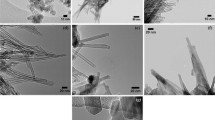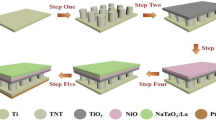Abstract
Self-organized TiO2 nanotubes (TiNTs) have been synthesized by electrochemical anodization in an electrolyte containing ethylene glycol, ammonium fluoride, and de-ionized water at 40 V for 3 h. TiNTs were then annealed at different temperatures in air (that is 340 °C, 450 °C and 670 °C). All of the annealed TiNTs were then loaded with NiO using 0.2 M precursor concentration. Furthermore, TiNTs annealed at 450 °C were additionally loaded with NiO using 1.6 M precursor concentration. The XRD data revealed the formation of low-temperature anatase phase at 340 °C, high-temperature anatase at 450 °C and dominantly rutile phase of TiNTs at 670 °C. Addition of NiO to the TiNTs was also confirmed by XRD. SEM images revealed the morphological evolution of TiNTs at different annealing temperatures as well as loading of NiO. Raman spectroscopy results further confirmed the formation of different phases of TiNTs and the peak shifting as a result of NiO addition. The photoelectrochemical current (PEC) densities were recorded from zero to 1 V (vs. Ag/AgCl/3.5 M KCl) under 1 sun illumination in water without incorporating additional ions in it. TiNTs annealed at 450 °C showing anatase phase were found to be most promising for the PEC measurements in water. The current densities for the aforementioned TiNTs were enhanced by ~ 80 times with respect to dark measurement conditions. NiO addition using 0.2 M precursor concentration for 450 °C annealed anatase TiNTs produced a further fourfold increase in PEC densities under light with respect to its unmodified form. This is in contrast to ~ 1.6-fold and ~ 1.9-fold increase in PEC densities with respect to their unmodified forms for NiO-modified low-temperature anatase TiNTs and predominantly rutile-phase TiNTs, respectively. The NiO loading using 1.6 M precursor concentration in anatase TiNTs annealed at 450 °C exhibit PEC densities ~ sevenfold higher with respect to their unloaded form. This work highlights the roles of annealing temperature and NiO addition in TiNTs (particularly anatase phase) for achieving enhanced PEC densities for water splitting.












Similar content being viewed by others
References
Ali G, Kim HJ, Kum JM, Sung Oh C (2013) Rapid synthesis of TiO2 nanoparticles by electrochemical anodization of a Ti wire. Nanotechnology 24(18):185601. https://doi.org/10.1088/0957-4484/24/18/185601
Anpo M (1997) Photocatalysis on titanium oxide catalysts: approaches in achieving highly efficient reactions and realizing the use of visible light. Catal Surv Jpn 1(2):169–179. https://doi.org/10.1023/A:1019024913274
Anpo M (2000) Use of visible light. Second-generation titanium oxide photocatalysts prepared by the application of an advanced metal ion-implantation method. Pure Appl Chem 72(9):1787–1792. https://doi.org/10.1351/pac200072091787
Balaji S, Djaoued Y, Robichaud J (2006) Phonon confinement studies in nanocrystalline anatase-TiO2 thin films by micro Raman spectroscopy. J Raman Spectrosc 37(12):1416–1422. https://doi.org/10.1002/jrs.1566
Bousoulas P, Michelakaki I, Tsoukalas D (2014) Influence of oxygen content of room temperature TiO2–x deposited films for enhanced resistive switching memory performance. J Appl Phys 115(3):034516. https://doi.org/10.1063/1.4862797
Carp O, Huisman CL, Reller A (2004) Photoinduced reactivity of titanium dioxide. Prog Solid State Chem 32(1–2):33–177. https://doi.org/10.1016/J.PROGSOLIDSTCHEM.2004.08.001
Chen J-Z, Chen T-H, Lai L-W, Li P-Y, Liu H-W, Hong Y-Y, Liu D-S et al (2015) Preparation and characterization of surface photocatalytic activity with NiO/TiO2 nanocomposite structure. Materials 8(7):4273–4286. https://doi.org/10.3390/ma8074273
Chen G, Georgieva V, Godfroid T, Snyders R, Delplancke-Ogletree M-P (2016) Plasma assisted catalytic decomposition of CO2. Appl Catal B 190:115–124. https://doi.org/10.1016/J.APCATB.2016.03.009
Chen Q, Zhou M, Zhang Z, Tang T, Wang T (2017) Preparation of TiO2 nanotubes/reduced graphene oxide binary nanocomposites enhanced photocatalytic properties. J Mater Sci Mater Electron 28(13):9416–9422. https://doi.org/10.1007/s10854-017-6683-2
El-Sabban HA, Attia MS, Bakir E, Abdel-Mottaleb SA (2013) Synthesis and photocatalytic performance of AgO–TiO2 and AgI–TiO2 photocatalysts. Egypt J Pure Appl Sci 51:027–032
Frank O, Zukalova M, Laskova B, Kürti J, Koltai J, Kavan L (2012) Raman spectra of titanium dioxide (anatase, rutile) with identified oxygen isotopes (16, 17, 18). Phys Chem Chem Phys 14(42):14567–14572. https://doi.org/10.1039/c2cp42763j
Fujishima A, Honda K (1972) Electrochemical photolysis of water at a semiconductor electrode. Nature 238(5358):37–38. https://doi.org/10.1038/238037a0
Guo J, Fu W, Yang H, Yu Q, Zhao W, Zhou X, Sui Y et al (2010) A NiO/TiO2 junction electrode constructed using self-organized TiO2 nanotube arrays for highly efficient photoelectrocatalytic visible light activations. J Phys D Appl Phys 43(24):245202. https://doi.org/10.1088/0022-3727/43/24/245202
Han H, Riboni F, Karlicky F, Kment S, Goswami A, Sudhagar P, Yoo J et al (2017) α-Fe2O3/TiO23D hierarchical nanostructures for enhanced photoelectrochemical water splitting. Nanoscale. https://doi.org/10.1039/c6nr06908h
Ho W, Yu JC, Lee S (2006) Synthesis of hierarchical nanoporous F-doped TiO2 spheres with visible light photocatalytic activity. Chem Commun 42(10):1115. https://doi.org/10.1039/b515513d
Hu C, Chu K, Zhao Y, Yang WT (2014) Efficient photoelectrochemical water splitting over anodized P-type NiO porous films. ACS Appl Mater Interfaces. https://doi.org/10.1021/am507138b
Iandolo B, Zhang H, Wickman B, Zorić I, Conibeer G, Hellman A (2015) Correlating flat band and onset potentials for solar water splitting on model hematite photoanodes. RSC Adv 5(75):61021–61030. https://doi.org/10.1039/C5RA10215D
Ku Y, Lin C-N, Hou W-M (2011) Characterization of coupled NiO/TiO2 photocatalyst for the photocatalytic reduction of Cr(VI) in aqueous solution. J Mol Catal A: Chem 349(1–2):20–27. https://doi.org/10.1016/J.MOLCATA.2011.08.006
Kudo A, Miseki Y (2009) Heterogeneous photocatalyst materials for water splitting. Chem Soc Rev 38(1):253–278. https://doi.org/10.1039/B800489G
Kumar A, Madaria AR, Zhou C (2010) Growth of aligned single-crystalline rutile TiO2 nanowires on arbitrary substrates and their application in dye-sensitized solar cells. J Phys Chem C. https://doi.org/10.1021/jp100491h
Liu Q, Ding D, Ning C, Wang X (2015) Reduced N/Ni-doped TiO2 nanotubes photoanodes for photoelectrochemical water splitting. RSC Adv 5(116):95478–95487. https://doi.org/10.1039/c5ra21805e
Mohapatra SK, Misra M, Mahajan VK, Raja KS (2007) Design of a highly efficient photoelectrolytic cell for hydrogen generation by water splitting: application of TiO2-XC × nanotubes as a Photoanode and Pt/TiO2 nanotubes as a cathode. J Phys Chem C. https://doi.org/10.1021/jp071906v
Murphy AB (2008) Does carbon doping of TiO2 allow water splitting in visible light? Comments on ‘Nanotube enhanced photoresponse of carbon modified (CM)-n-TiO2 for efficient water splitting.’. Sol Energy Mater Sol Cells 92(3):363–367. https://doi.org/10.1016/J.SOLMAT.2007.10.007
Rasheed MA, Ahmad K, Khaliq N, Khan Y, Rafiq MA, Waheed A, Shah A, Mahmood, Ali G (2018) Effect of electrochemical reduction on the structural and electrical properties of anodic TiO2 nanotubes. Curr Appl Phys. https://doi.org/10.1016/j.cap.2018.01.001
Sakthivel S, Janczarek M, Kisch H (2004) Visible light activity and photoelectrochemical properties of nitrogen-doped TiO2. Appl Chem B 108(50):19384–19387. https://doi.org/10.1021/JP046857Q
Sim L, Ching KW, Ng S, Ibrahim, Saravanan P (2013) Preparation of improved p–n junction NiO/TiO2 nanotubes for solar-energy-driven light photocatalysis. Int J Photoenergy 2013:1–10. https://doi.org/10.1155/2013/659013
Sreethawong T, Suzuki Y, Yoshikawa S (2005) Photocatalytic evolution of hydrogen over mesoporous TiO2 supported NiO photocatalyst prepared by single-step sol–gel process with surfactant template. Int J Hydrogen Energy 30(10):1053–1062. https://doi.org/10.1016/J.IJHYDENE.2004.09.007
Sun B, Shi T, Peng Z, Sheng W, Jiang T, Liao G (2013) Controlled fabrication of Sn/TiO2 nanorods for photoelectrochemical water splitting. Nanoscale Res Lett. https://doi.org/10.1186/1556-276X-8-462
Szkoda M, Siuzdak K, Lisowska-Oleksiak A (2016) Non-metal doped TiO2 nanotube arrays for high efficiency photocatalytic decomposition of organic species in water. Phys E 84:141–145. https://doi.org/10.1016/J.PHYSE.2016.06.004
Umebayashi T, Yamaki T, Itoh H, Asai K (2002) Band gap narrowing of titanium dioxide by sulfur doping. Appl Phys Lett 81(3):454–456. https://doi.org/10.1063/1.1493647
Wang G, Wang H, Ling Y, Tang Y, Yang X, Fitzmorris RC, Wang C, Jin Z, Zhang, Li Y (2011) Hydrogen-treated TiO2 nanowire arrays for photoelectrochemical water splitting. Nano Lett. https://doi.org/10.1021/nl201766h
Wunderlich W, Oekermann T, Miao L, Hue NT, Tanemura S, Tanemura M (2004) Electronic properties of nano-porous TiO2- and ZnO-thin films-comparison of simulations and experiments. J Ceram Process Res 5(4):343–354
Xiao F-X (2012) Construction of highly ordered ZnO–TiO2 nanotube arrays (ZnO/TNTs) heterostructure for photocatalytic application. ACS Appl Mater Interfaces 4(12):7055–7063. https://doi.org/10.1021/am302462d
Xu M, Da P, Wu H, Zhao D, Zheng G (2012) Controlled Sn-doping in TiO2 nanowire photoanodes with enhanced photoelectrochemical conversion. Nano Lett. https://doi.org/10.1021/nl2042968
Yamashita H, Harada M, Misaka J, Takeuchi M, Ikeue K, Anpo M (2002) Degradation of propanol diluted in water under visible light irradiation using metal ion-implanted titanium dioxide photocatalysts. J Photochem Photobiol A 148(1–3):257–261. https://doi.org/10.1016/S1010-6030(02)00051-5
Zhang Z, Hossain MF, Takahashi T (2010a) Photoelectrochemical water splitting on highly smooth and ordered TiO2 nanotube arrays for hydrogen generation. Int J Hydrogen Energy 35(16):8528–8535. https://doi.org/10.1016/J.IJHYDENE.2010.03.032
Zhang Z, Shao C, Li X, Wang C, Zhang M, Liu Y (2010b) Electrospun nanofibers of p-type NiO/n-type ZnO heterojunctions with enhanced photocatalytic activity. ACS Appl Mater Interfaces 2(10):2915–2923. https://doi.org/10.1021/am100618h
Zhou W, Du G, Hu P, Li G, Wang D, Liu H, Wang J, Boughton RI, Liu D, Jiang H (2011) Nanoheterostructures on TiO2 nanobelts achieved by acid hydrothermal method with enhanced photocatalytic and gas sensitive performance. J Mater Chem. https://doi.org/10.1039/c1jm10588d
Acknowledgements
PIEAS, NCP, and NILOP are gratefully acknowledged.
Author information
Authors and Affiliations
Corresponding authors
Ethics declarations
Conflict of interest
On behalf of all authors, the corresponding author states that there is no conflict of interest.
Additional information
Publisher’s Note
Springer Nature remains neutral with regard to jurisdictional claims in published maps and institutional affiliations.
Rights and permissions
About this article
Cite this article
Rasheed, M.A., Rahimullah, R., Uddin, S.K. et al. Role of temperature and NiO addition in improving photocatalytic properties of TiO2 nanotubes. Appl Nanosci 9, 1731–1742 (2019). https://doi.org/10.1007/s13204-019-00980-z
Received:
Accepted:
Published:
Issue Date:
DOI: https://doi.org/10.1007/s13204-019-00980-z




